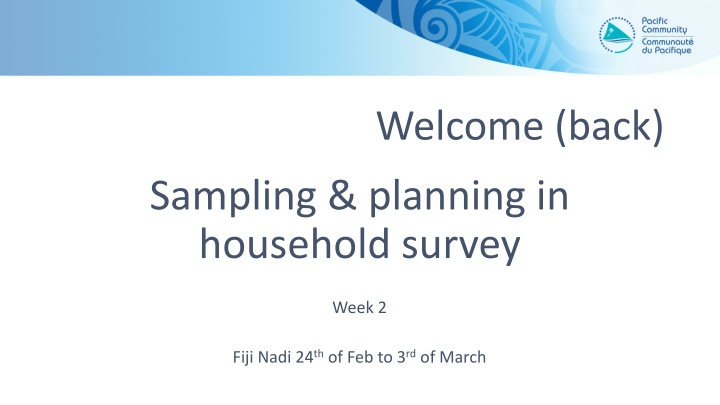
Household Survey Sampling and Planning in Fiji: Week 2 Overview
Explore topics covered in Week 2 of the household survey in Fiji, including random selection, field plan preparation, and survey budgeting. Dive into survey parameter control and design considerations for survey precision and error reduction.
Download Presentation

Please find below an Image/Link to download the presentation.
The content on the website is provided AS IS for your information and personal use only. It may not be sold, licensed, or shared on other websites without obtaining consent from the author. If you encounter any issues during the download, it is possible that the publisher has removed the file from their server.
You are allowed to download the files provided on this website for personal or commercial use, subject to the condition that they are used lawfully. All files are the property of their respective owners.
The content on the website is provided AS IS for your information and personal use only. It may not be sold, licensed, or shared on other websites without obtaining consent from the author.
E N D
Presentation Transcript
Welcome (back) Sampling & planning in household survey Week 2 Fiji Nadi 24thof Feb to 3rdof March
Topics to cover on week 2 - Recap on week 1 - Random selection - Preparation of field plan - Survey Budget - Recommandations on questionnaire design (HIES) Outcomes of the RMI HIES experiment - Standard HIES / LFS questionnaires on CAPI - Sampling guidelines review & provide feedbacks
Recap on week 1 survey estimates The overall objective is to get good quality of the survey estimates, which means: Increase the survey precision Decrease the standard error Decrease the relative standard error (RSE) Decrease the relative margin of error (RME) Reduce the width of the 95% confidence interval (CI) The more the variable of interest is volatile, the more difficult it is to get a good precision of the estimate of this variable of interest
Recap on week 1 survey estimates What are the survey parameters that we control when we start planning the sample: The type of survey design (stratified SRS, multi stage) The total sample size (n) The stratification (relevant only in stratified design) The sample allocation across strata The cluster size (m) (relevant only in multi stage design)
Recap on week 1 the survey design The survey design can be stratified SRS or multi stage (complex) In all but the smallest countries, stratified SRS is impossible to implement for budget and logistical reasons. The multi stage design (complex) is more appropriate in large countries, could be 2 stages or more. But by using a complex design, we are losing in precision compared to SRS and increasing the standard error (e) by the design effect (deff): e(complex) = ???? ?(???)
Recap on week 1 the sample size (n) The sample size does not depend on the population size To compute the sample size we need to: use the information collected on previous survey regarding this indicator of interest (proportion or mean, variance, design effect) use the formulas from sampling theory to predict the precision for the next survey, given a sample size of n By increasing the sample size the error (RME or RSE) will decrease It is important to apply the fpc correction at the end of the process
Recap on week 1 stratification The stratification in household surveys shows multiple benefits: It guarantees the representativeness of a sub group if the objective is to report on this sub group (small provinces, population of households with disability ) It reduces the standard error by having a better control of the composition of the sample
Recap on week 1 sample allocation The survey precision will depend on how the total sample size is allocated across the different stratas Different scenarios of allocation are possible (proportional, equal, optimal ) Each allocation scenario provides different precisions. It depends on the objective of the survey (National or strata level in priority) The proportional and optimal allocations will provide better estimates at the National level compared to the equal allocation (strata level)
Recap on week 1 the cluster size (m) Cluster size (m) is only relevant in multi stage design It represents the number of survey units (households) that we will select in each of the Primary Sampling Unit (PSU). In most of the cases the PSUs are EAs or census blocks By increasing the cluster size the error will increase By decreasing the cluster size the error will decrease
Recap on week 1 the non sampling error The non sampling error cannot be measured The non sampling error should be avoided as much as possible Ways to avoid or to minimise the non sampling error: Quality of the recruitment (that guarantees good field workers) Quality of the training Good field supervision done by NSO/survey management
